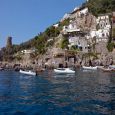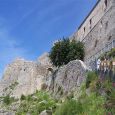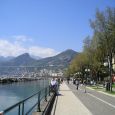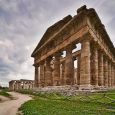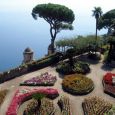Salerno
Advertisement
By Air
The Salerno airport at Pontecagnano, in the souther outskirt of the city, started international passenger traffic in July 2008.There were direct flights to Milan Malpensa (Italy), Barcelona (Spain) and Bucharest Baneasa (Romania).
By Train
In 2010 the "Metropolitan railway service" connecting the historical center with the new eastern areas of the town (and, in the future, the airport at Pontecagnano) was completed.As of May 2011, it has still be activated.From Napoli Central or Piazza Garibalidi you can easily reach Salerno by train. The regional trains ticket to Salerno costs around 3-4 euros and it's called U-5 Unico Campania. Other trains are more expensive and cost around 7-10 euros.
By Bus
The service is quite rapid for the first part of the journey, but then will leave the motorway and take a more tortuous route.The journey should take an hour so so.The ticket should cost between 3 and 4 Euros per person.You should ask the way to the "SITA" (the name of the bus company that provides the service).If you stand where the bus stops, and face the sea (with the tall castle to your right), you will need to cross the main road and head towards the left. After about 400 meters or so, you will see a small congregation of buses to your right.Check the destination written on the bus, or you can ask for "Salerno".
Salerno Cathedral
is the main church of the city of Salerno in southern Italy.It is considered the main tourist attraction of the city.It is dedicated to Saint Matthew, one of the four Evangelists, whose tomb is inside the Cripta.The Cathedral was built at the center of Salerno, when the city was the capital of the Principality of Salerno in southern Italy (that stretched from the gulf of Naples to the Ionian sea).Begun by Robert Guiscard in 1076 during the episcopate of Alfano I on a pre-existing church (in turn erected over a Roman temple's ruins), the Duomo was consecrated by Pope Gregory VII in 1085.The Duomo Museum houses artworks from different ages, including the silver statues of the Salernitane Martyrs (13th century) and documents of the renowned Schola Medica Salernitana (the first University of Europe, according to some scholars like G. Crisci).The crypt, believed to house the remains of St. Matthew, is a groin vaulted hall with a basilica-like plan divided by columns. It was restored under design by Domenico Fontana in 1606-1608, with marble decorations added in the 18th century.
Provincial Archaeological Museum
The Provincial Archaeological Museum of Salerno collects archaeological finds from the province of Salerno and the city itself.Open to the public in 1927, from 1964 is housed in the former convent of the church of St. Benedict.The structure housed a courtyard surrounded by a portico of which there are seen the remains and probably a few columns from the hole, was partially demolished by the building of Via S. Benedict.Outside you can still see the arch and corbels for the Castelnuovo di Margherita of Durazzo.Upstairs are the remains from Salerno, from pre-Roman settlement of Fratte , until the Lombard period.During the work of reorganization of the museum stores, many oil lamps were found referring to a workshop dated between the I and the second century BC Part of the museum is an old Greek bronze head depicting the god Apollo, impigliatasi in 1931 in networks Salerno of a fisherman.He is currently closed for renovations.
Educational museum of medical school
is located in Via dei Mercanti, the oldest shopping street of the old town of Salerno, near the cathedral.The museum is housed inside the Church of San Gregorio, built in the Lombard period of Salerno around the one thousand years.Through reproductions of documents, miniatures and photographs, the museum displays the history of the School of Medicine, especially in its centuries of glory ( X - XIII century ).There are shown in light panels, reproductions of precious illuminated manuscripts and production of the medieval Medical School of Salerno.After a period of restructuring and interior of the church that houses it, on 18 December 2009 the museum was reopened with a new museum project and an interactive, multimedia set-up, changing into a museum Virtual School of Medicine.
Diocesan Museum
is housed in the former workshop archbishop (first used to house the School of Medicine , which was abolished there in 1811 ), and is a point of reference for understanding the history and culture of the bell from the Middle Ages the eighteenth century.Inside there are important historical records of the twelfth century and a series of codes manuscripts of the thirteenth and fourteenth centuries.Among them stands the 'Exultet, a long roll of parchment covered with fine miniatures illustrating a prayer of the Holy Week of the same name ("Exultet iam Angelica Turba caelorum."), and" rolled "by the deacon during the sermon to make it understand the Latin words to the ignorant populace.The work dates from the mid-thirteenth century.Also decorated with miniatures is a book dating from the Pontifical 1180 and invoice Bolognese, made specifically for the cathedral of Salerno.You can also admire a number of paintings belonging to the Neapolitan School and School of Salerno.Among them stand out paintings of Angelo Solimena (father of the more famous Francis ), Massimo Stanzione, Caravaggio and others of the 600.
Etruscan-Samnite archaeological area of Fratte
is on the outskirts of north-eastern city of Salerno along the river Irno, in today's district of Fratte.Around the sixth century BC, groups of Etruscans , probably from Amina, now Pontecagnano Faiano, moved into the valley of the river Irno, not far from its mouth.The city, identified with the Marcina quoted by Strabo or IRNA for some coins found with the legend IRNTHI (of IRNA), was subsequently occupied by the Samnites, who remained there until the third century before Christ.Perhaps the Romans destroyed the small town in the context of military operations subsequent to the Samnite wars.The ancient Etruscan town Samnite roofs with architectural decoration was polychrome bas-reliefs in the temple with a so-called "Etruscan acropolis" and constructions of tufa, which infer that the town of Fratte had a sufficiently developed urban-type structure.The archaeological material unearthed in the excavations of the site are displayed in a special section in the Provincial Archeological Museum in Salerno.
Beacon of Justice
is a monument of contemporary art place in the northern corner of the building "Judicial Citadel" of Salerno.The inauguration ceremony was held in September 2006 as part of the traditional events that precede the feast of St. Matthew the Apostle and Evangelist, patron saint of the city.The monument, designed by the artists Ben Jakober and Yannic Vu, has been selected by the art critic Achille Bonito Oliva and has been proposed by the Spanish architect Oriol Bohigas a prize for contemporary architecture.The Beacon of Justice, which is part of the ornamental work of the new "Judicial Citadel" of Salerno, has more than nine meters high and is made of polychrome marble, with panels of black and white.
Lungomare Trieste
is a large garden with trees (entirely pedestrian, 30 meters wide and about 2 km long) along the coast in the central part of the urban, the Commercial Port in tourism.This is one of the most beautiful coastal walks Italy for the luxuriant exotic vegetation and the spectacular views of the Gulf of Salerno, with the mountains of the Amalfi coast in the background.The palm of the Promenade is twinned with that of Sanremo, for the protection of botanical science.In 2006 - the 2007th, an insect pest from Asia ( Rhynchophorus ferrugineus ) lethal to the plants attacked some palm trees, which were torn down and replaced promptly.
Arechis Castle
was built on Mount Bonadies, which is 300 metres above sea level and dominates the town from the north forming a triangular defensive system.The castle attained military importance in the 8th Century, during the reign of the Lombard Prince Arechi II, who extended and rebuilt it to the standards of Roman and Byzantine times.It was considered a strategic position for the town on the Mediterranean coast and an excellent access both for commercial and for defensive purposes, hence the fortification of the old Salernum, which became Capitol of the Benevento Duchy.
January - April
August - November


